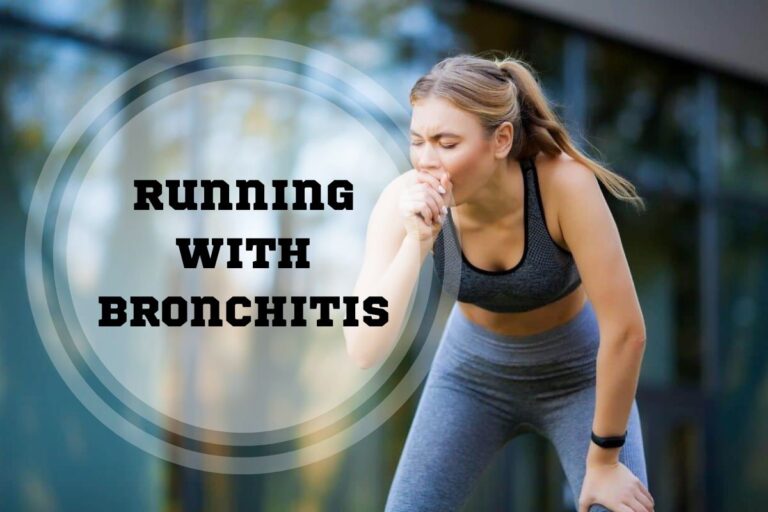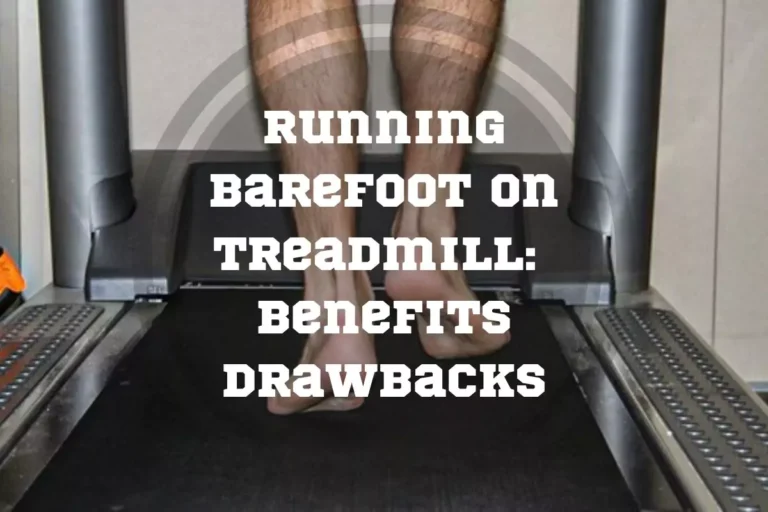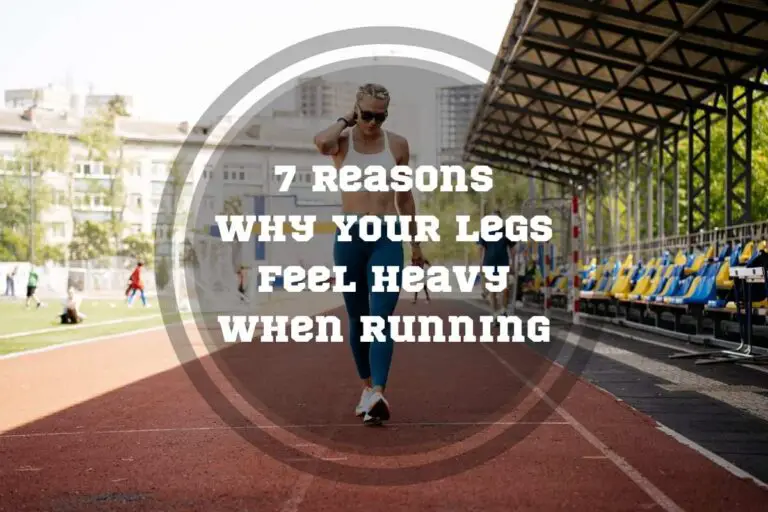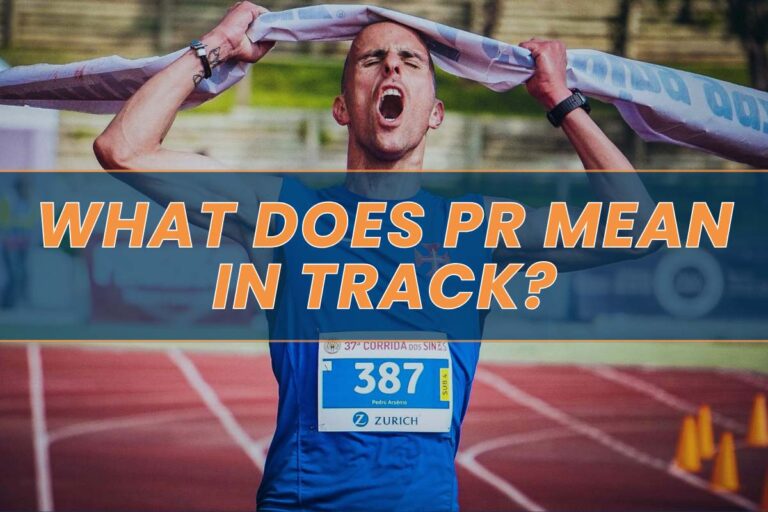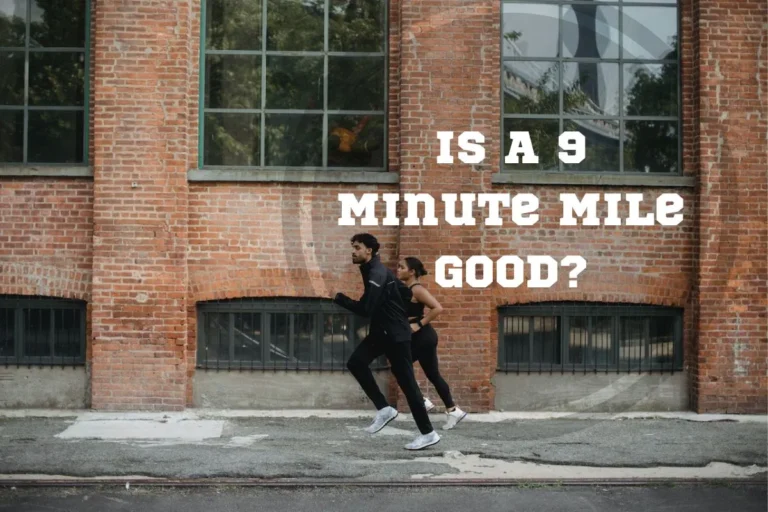Best 5 Hip Stretches For Runners To Boost The Stride
Stretching is vital for maintaining muscle and joint flexibility, which helps prevent injuries, alleviate muscle tension, and improve overall mobility. Regular stretching routines can enhance circulation, reduce stress, and contribute to better posture, making it an essential component of a healthy and active lifestyle. Improving flexibility is crucial for runners.
Having increased hip tightness is a common problem affecting runners. Improving the flexibility and mobility at the hip is an essential to improving runner performance. This article will discuss why hip stretches for running are super-important. We’ll cover the benefits of hip stretches for runners, when you should do it, and the best hip stretches for runners.
Let’s dive in!
Why should runners do Hip Stretches?
Hip stretches for runners, like hamstrings, gluteal stretch, dynamic stride stretch, and hip glide stretch, help increase mobility and flexibility. Practicing hip stretches for running also improves your overall running performance and mechanics. Additionally, they help you develop better shock absorption and reduce hip and back pain.
What is Hip Stretches For Runners?
When discussing the importance of hip flexor exercises for runners we should start with the hip complex.
The hip complex, often called the hip joint or hip region, is a ball-and-socket joint connecting the thigh bone (femur) to the pelvis. It is one of the most significant and most stable joints in the human body and plays a crucial role in supporting body weight, enabling leg movement, and providing stability for various activities, including walking, running, and sitting. The hip complex includes several vital structures, such as bones, ligaments, muscles, and tendons, all working together to facilitate motion and bear loads.
These structures are responsible for shaping and supporting your hips. The muscles in the hip complex area enable enhanced flexibility and mobility within the hip joint and play a crucial role in fluid running. So that’s where incorporating runner stretches into your routine is handy.
Moreover, the hip complex is closely connected to the iliopsoas muscles—a big compound muscle of the inner hip. The iliopsoas muscle presents the primary flexor of the hip joint, connecting the spine to the femur.
Simply put, these muscles play a crucial role when lifting your leg toward your chest. For instance, when you’re climbing stairs, your iliopsoas muscles work to bend your hip joint and lift your thigh.
After explaining the hip complex, let’s discuss types of post and pre-run hip stretches.
Static vs. Dynamic Stretching
Stretching is usually divided into two groups: static stretching and dynamic stretching. Each stretch has its own purpose to help your body maintain one’s balanced condition for an efficient run.
Static stretching is always recommended after a workout to help your muscles recover and maintain flexibility. It usually involves moving a joint as far as it will go naturally and then keeping that position. This is an effective way to relax your muscles, increase your range of motion and prevent post-exercise soreness.
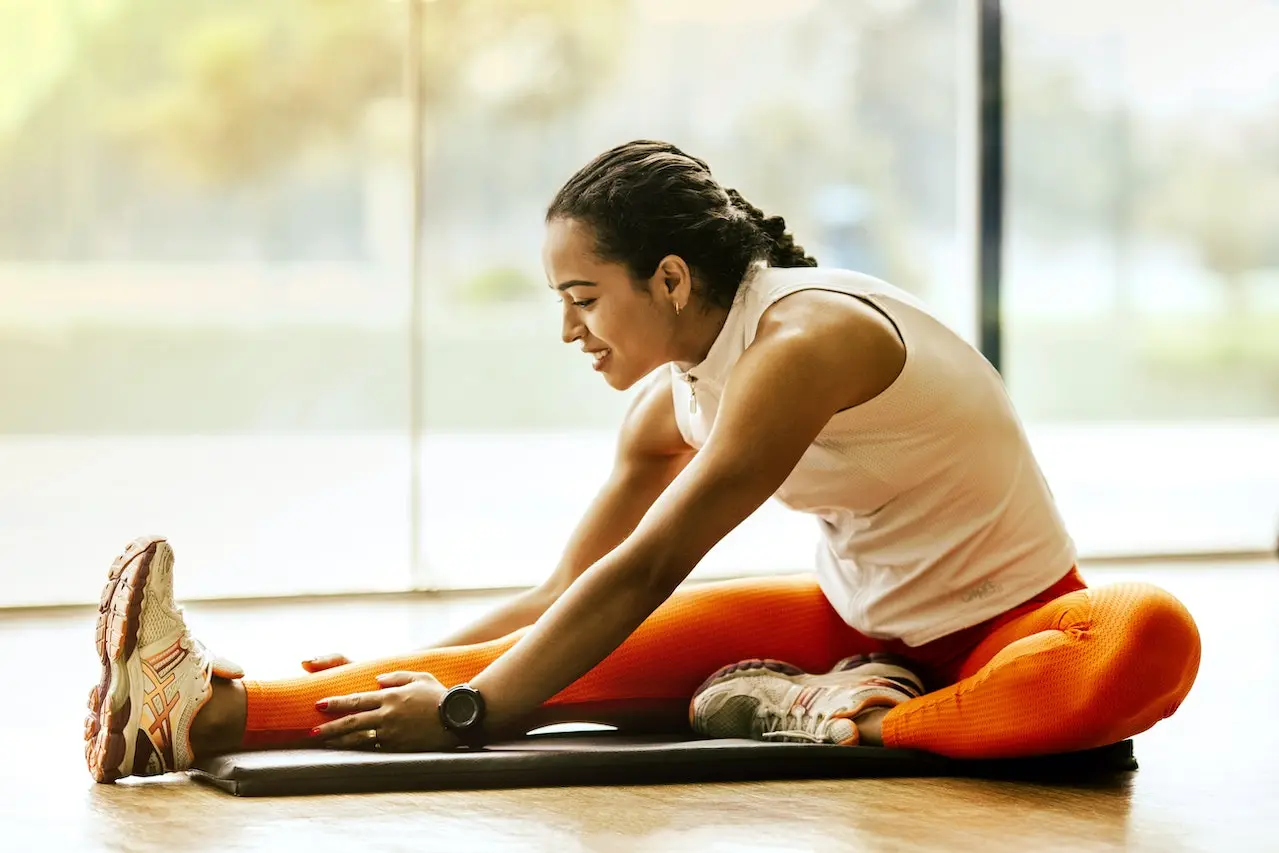
For instance:
- Touching your toes and keeping that position for a certain period.
- Interlock your fingers and place them above your head. Your lower back should be slightly arched inwards or flat. Feel free to perform this exercise sitting or standing.
- Place your right hand behind your head and reach as far down your back as possible. With your left hand, grasp your right elbow and gently pull it behind the back of your head.
On the other hand, dynamic stretching aims at helping your muscles rehearse the type of movement they’ll be doing when running. It’s also a good option when implementing stretches for hip pain from running, as it activates the muscle, causing it to contract and warm up.
Make sure to engage in dynamic stretching before a run to boost blood flow, improve muscle elasticity, and enhance running performance.
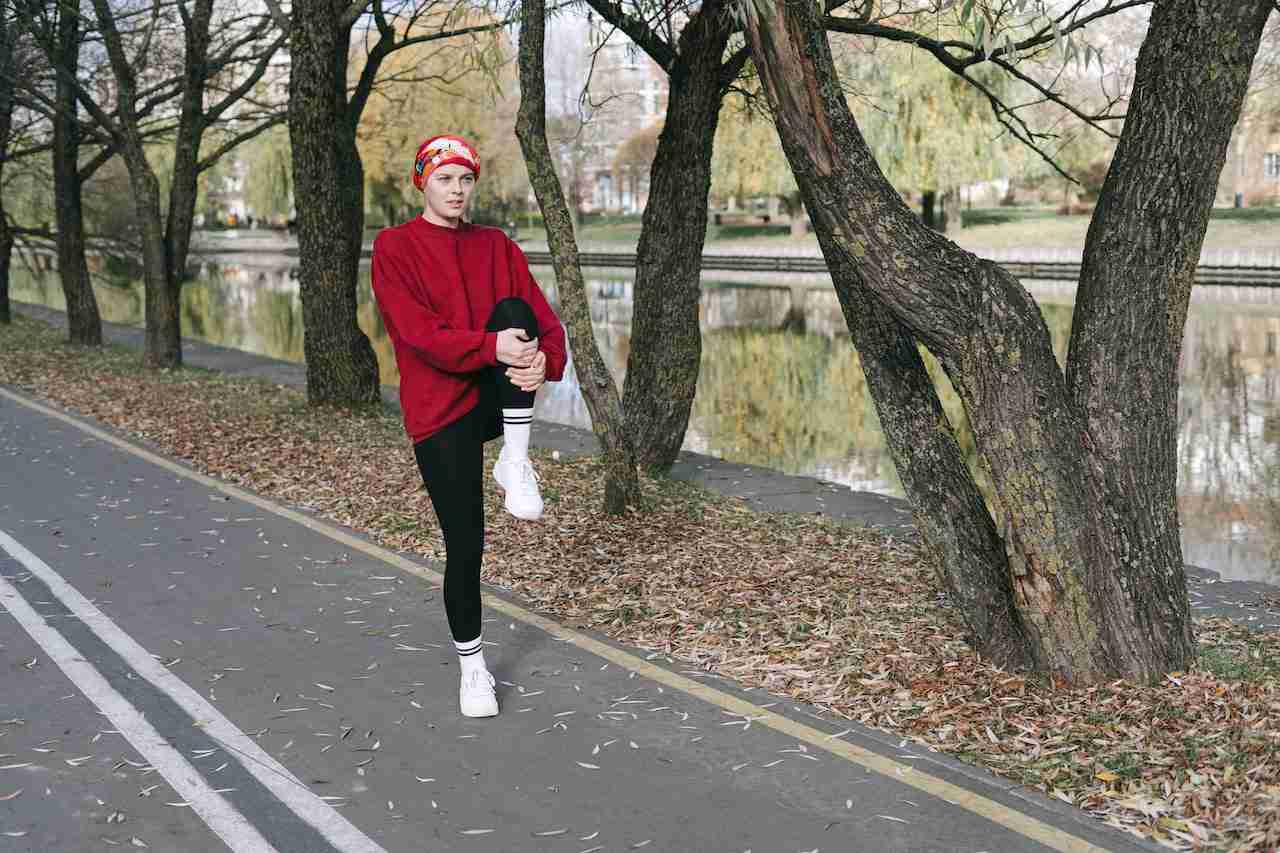
For instance:
- Stand on one leg and swing the opposite leg in circles out to the side. Do 15 processes in each direction. Aim to increase the size of the circles as you become more flexible.
- Stand with your shoulder width apart and parallel feet. Step forward with your right leg and then raise your left knee toward your chest. Use both hands to pull the knee up higher. Do this exercise five times on each leg.
- Stand with your feet and shoulder width apart. Take a step forward and place your left heel on the ground, rolling forward onto the ball of your foot.
5 Benefits of Doing Hip Stretching Exercises for Runners
The advantages of hip stretches for runners are non-negotiable. These stretches target the hip muscle, which is crucial in a runner’s range of motion and lower body movement. Implementing stretching into your running routine contributes to your ease of movement and building resilience.
In detail, let’s discuss some key benefits of doing hip stretches for runners in fact!
1. Increased Mobility and Flexibility
If you’re experiencing discomfort while running, it could be that your hip may be tight. The muscles surrounding the hips, such as the hip flexors, adductors, and rotators, become tight due to prolonged sitting at work or an inactive lifestyle. Here’s where hip flexor exercises for runners gently release and stretch these tight muscles, improving their range of motion.
2. Improved Running Mechanics
Hip stretches before running or after running certainly help your overall running mechanics. By increasing the mobility and flexibility of the hip complex and all its muscles, overall functionality rises, too.
Subscribe to Our Running Newsletter!
Get free running tips from renowned professional athletes and discounts from top-notch brands.
3. Better Shock Absorption
Hip stretches help you prepare your lower body for better ground contact. Your legs will adapt quicker and reduce the impact on your joints. This is extremely important if you’re running on hills or uneven surfaces.
4. Increased Range of Motion
Stretching will help you move your legs freely when running and feel more comfortable. This is due to the increased motion in your hip joint and the muscles surrounding it – the hip complex.
5. Reduced Hip and Lower Back Pain
It’s often because of our stressful lifestyles and poor posture that we cause the muscles to compress and tighten, resulting in lower back and hip pain. Hip stretches after running or before will loosen the hip muscle, alleviate this strain, and maintain a better running posture.
When to do Hip Stretches?
Now, as we have discussed the importance and potential benefits of hip stretches for running, you might wonder: When should I do it, before or after running? Let’s examine both options so you can be informed while deciding about stretching timing.
Stretching Before A Run
Stretching before a run can serve you as a mental cue that you need to focus on your workout. Also, the adequately induced dynamic stretch will activate and warm up your hip complex.
However, some exercise physiologists say stretching doesn’t impact a runner’s performance. Also, many runners don’t understand that when you grab your toe for a static stretch and you feel the sensation going through your leg, it’s not actually a good one. What you’re doing is just tearing the muscle fiber.
Stretching After A Run
Stretching after running improves overall hip flexibility and improves blood circulation. When you stretch after a run, your muscles are already warmed up, which makes them more receptive to lengthening. It’s a beneficial ending to your running.
However, not stretching after a run can drastically reduce mobility in your muscles and joints, indirectly increasing your risk of injury.
Hip Stretching Tips
- Listen to your body – If you’re uncomfortable and uncomfortable with a particular stretch, or it causes discomfort and pain, don’t do it. Stretching should make you feel better and at ease.
- Stay hydrated – Hydrated plays an essential role in muscle recovery, so drink enough water before and after stretching.
- Be consistent – Regular stretching may lead to long-term benefits, such as flexibility and easier muscle recovery.
- Take deep breaths – While stretching, focus on your breathing and relax into the stretch. Don’t force any stretch.
- Work on your tight areas – If you feel tension and soreness in specific muscles, focus on them. Pay extra attention to stretch and release tension from these muscles gently.
Best Hip Stretches For Runners: Top 7 Exercises
Here are some of the best strengthening exercises you can do before or after a run.
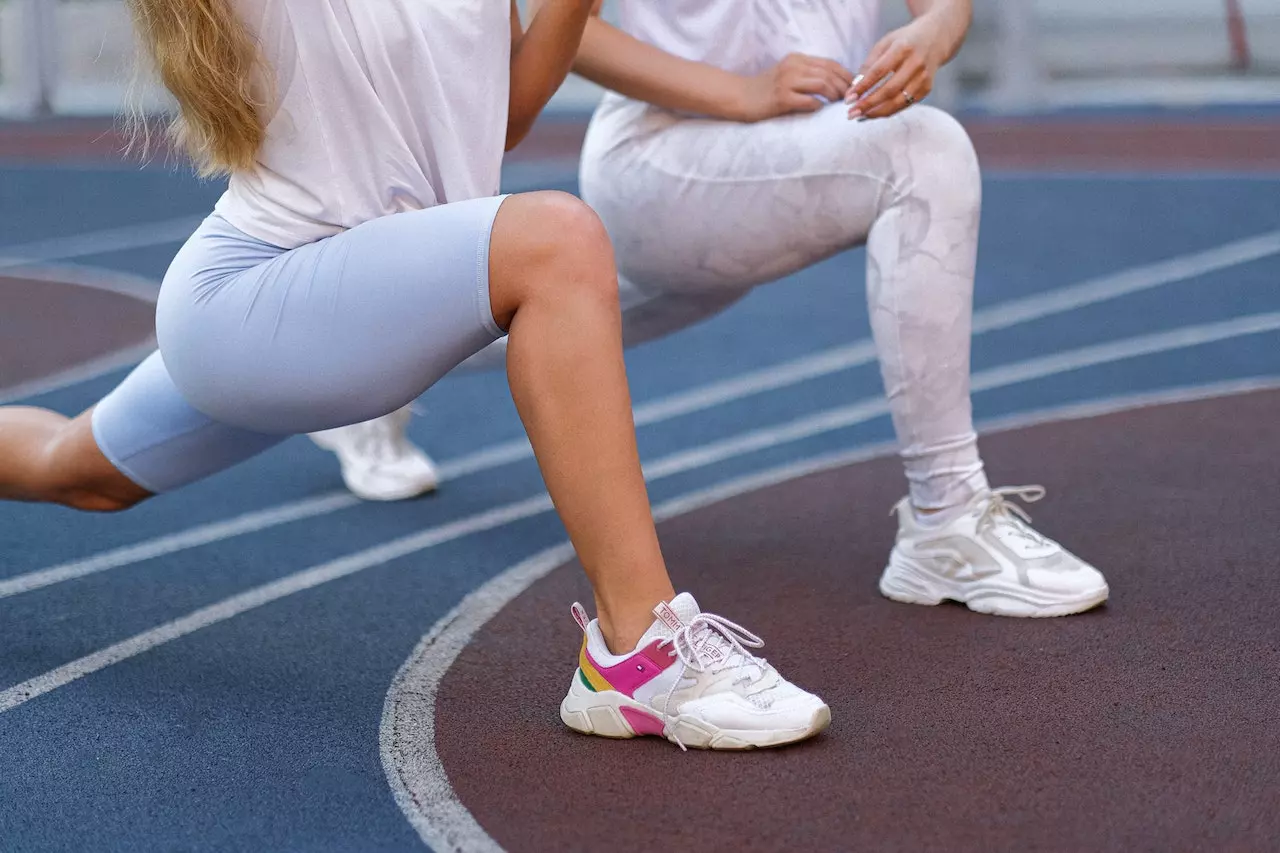
1. Leg Back Stretch
The hamstrings are an important group of three muscles located at the back of your thigh, stretching from the hip to the knee. Runners often experience tight hamstrings due to repetitive running motion, so this stretch also benefits your muscles.
Here’s how to do it:
- Sit on the ground extending your left leg
- Move your foot to your inner thigh, and if possible, touch the top of your left leg
- Lean forward toward reaching your toes, and try not to round your back when bending
- Hold for 30 seconds
- Repeat the other leg
2. Gluteal Stretch
Gluteal stretch lengthens the gluteal muscles and plays a pivotal role in supporting the movements involved in running. This stretch helps stabilize the hip joint and improves your running posture.
Here’s how to do it:
- Lie on your back with bent knees and flat feet on the floor
- Cross your left ankle over your right knee
- Grab behind your right knee and bring your leg to your chest
- Hold for 30 seconds, then switch to the other side.
3. Hip-Front Opener Stretch
This muscle on the front of your spine connects the lower back to the upper thigh. The psoas muscle, also known as “the main hip flexor,” interacts with the core muscles, contributing to a runner’s core stability and engagement. Incorporating hip-front stretches can lead to reduced muscle strain.
Here’s how to do it:
- Kneel on both knees with your right leg in front at 90 degrees
- Shift your hips forward with squeezed glutes
- Raise your left arm over your head and stretch it to the correct
- As you stretch, to the right, open the torso to the left.
4. Lower Leg Muscle Stretch:
You should pay attention to your calf muscles, which are a vital area while running. A calf stretch targets the muscles at the back of your lower leg, which controls ankle movement, foot stability, and lower limb function. Proper calf flexibility enables efficient running while reducing the strain on your hip.
Here’s how to do it:
- Step with your left leg forward and bent knee
- Extend your right leg straight back with your heel flat on the floor
- Keep the right leg straight while you lean toward the wall.
5. Inner Thigh Stretch
This stretch targets the adductor muscles, which significantly maintain hip balance. Additionally, the inner thigh stretch will help you alleviate tightness in the inner thighs and add fluidity to your run. Well-stretched adductor muscles enable a wider range of motion, leading to proper body alignment.
Here’s how to do it:
- Stand with your feet spread apart
- Without moving any of your legs, lean to the left side and bend your knee until you feel a stretch.
- Hold for 30 seconds, then switch
6. Dynamic Stride Stretch
This stretch will increase your range of motion and prepare you for longer strides. It will give you smoother and more relaxed movement during a run. It’s important because it improves the elasticity of your hip joint and the surrounding muscles.
Here’s how to do it:
- Start by positioning your feet hip-width apart
- Step forward with your left foot
- Gradually lower your body until your left foot is parallel to the floor
- Don’t forget to keep your back straight
- Hold the stretch for 30 seconds
- Repeat with the other leg.
7. Hip Glide Stretch
Hip glide stretch is focused on smooth hip movement and maintaining healthy hip joints. This can be an effective cool-down activity to release the built-up tension during a run. Concentrate on your controlled movement in this stretch enhances your body awareness.
Here’s how to do it:
- Sit upright with your knees bent and your hands behind for support
- Cross your right ankle over your left knee in a figure-four shape
- Let your right knee slide to the right, then return to the center
- Repeat this motion for a dynamic slide, then repeat with the other leg
Frequently Asked questions about Hip Stretches For Runners
How Do I Loosen My Tight Hips When Running?
Simply implement static and dynamic stretching into your running routine. Practice dynamic stretches like hip circles and leg swings before you run. And after running, do static stretching to help you relax your muscles.
How Do I Relieve Hip Pain From Running?
You can relieve hip pain by performing hip stretches before and after your run. Implementing calf stretch, adductors, and gluteal stretch will alleviate your hip pain and prepare you for the next run.
Summing up Best Hip Stretches Tips For Runners
Incorporating hip stretches isn’t just a recommended practice—it’s a game-changer for your routine. These simple yet effective stretches help you unlock your running potential and perform better.
So, next time you’re getting ready for a run, remember to get a few minutes for your hip stretching. Your hips will thank you, and you’ll feel the difference when running!
Tell ll us what you think of them in the comments if you’ve already tried them!
Also read:
- Best Running Insole
- Hoka Shoes vs Brooks
- Pickle Juice for Runners
- What Is Long Distance Running
- Best Running Shoes For Metatarsalgia
- Advanced 5k Training Plan
- Big Toe Joint Pain Running
- Best Running Shoes for Heel Strikers
References:
- Fernando Gomez-Pinilla, Charles Hillman, “The Influence of Exercise on Cognitive Abilities”, https://www.ncbi.nlm.nih.gov
- “Health Risks of an Inactive Lifestyle”, https://medlineplus.gov/
- Leigh-Ann Bramble, “Static vs. Dynamic Stretching: What Are They and Which Should You Do?”, https://www.hss.edu/
- Journal of Orthopaedic & Sports Physical Therapy, “Kinesiology of the Hip: A Focus on Muscular Actions”, https://www.jospt.org/
- Diego Muñoz Marín, José Alberto Frade Martins Parraca, Bernardino Javier Sánchez-Alcaraz Martínez, “The Influence of Stretching the Hip Flexor Muscles on Performance Parameters. A Systematic Review with Meta-Analysis”, https://www.ncbi.nlm.nih.gov/
If you have any questions or suggestions, you can contact us via email – [email protected]

